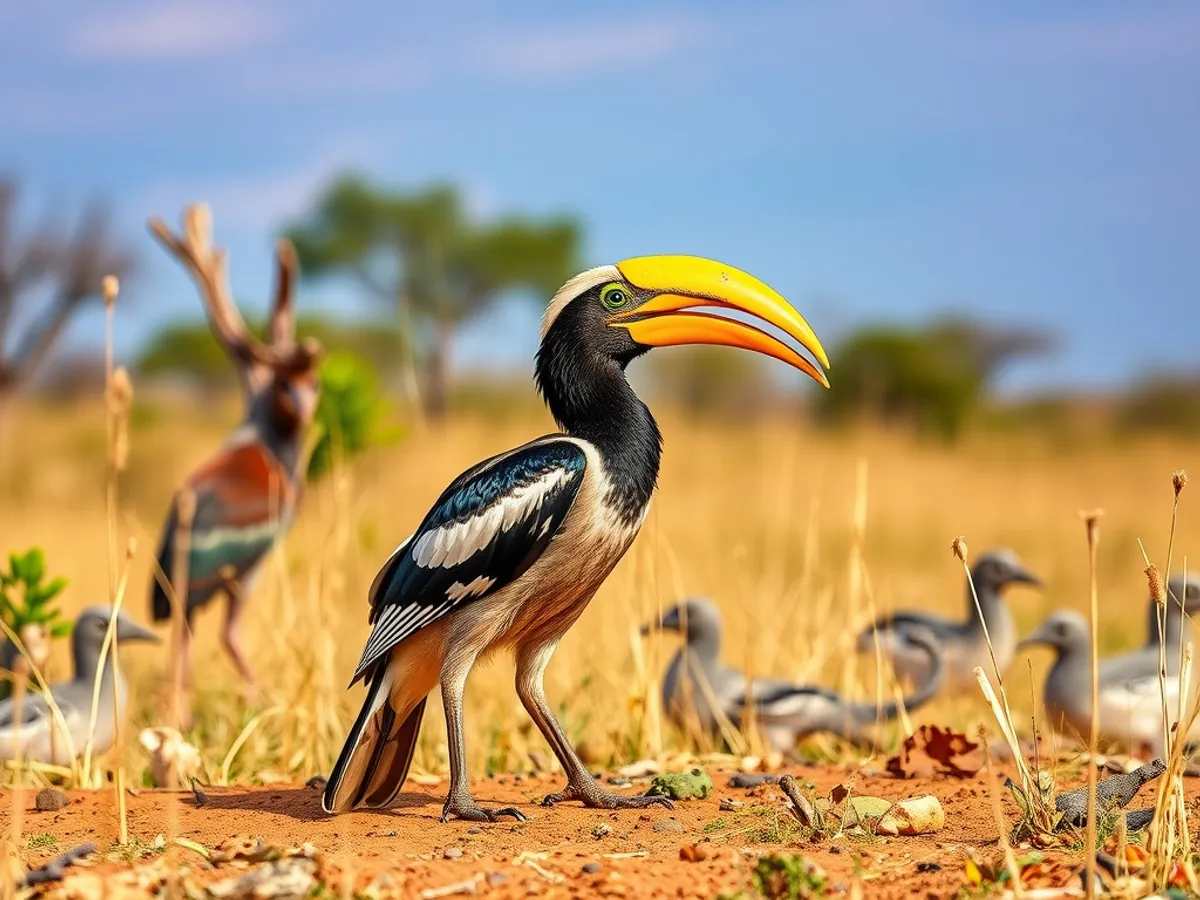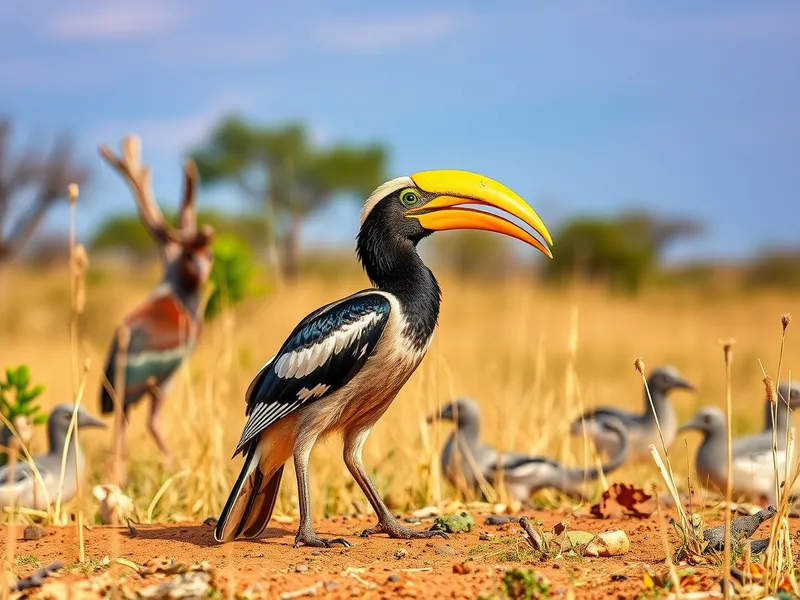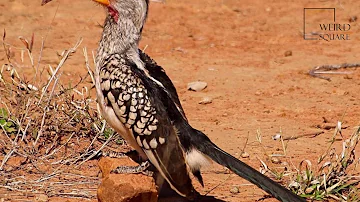
Yellow-billed Hornbill
Tockus leucomelas

Meet the Yellow-billed Hornbill
The Yellow-billed Hornbill is a striking medium-sized bird native to the dry savannas and woodlands of southern Africa. Recognizable by its large, curved yellow bill and contrasting black and white plumage, this hornbill is a common sight in its range. It is well adapted for ground foraging, often seen searching for insects, seeds, and small animals. Social and vocal, these hornbills display intriguing behaviors, such as their unique nesting habits where the female seals herself inside a tree cavity during incubation. Their charismatic appearance and comical movements have made them a favorite among wildlife observers.
Classification
Bird
Habitat
Savanna and dry woodland
Diet
Omnivore
Lifespan
10-15 years
Conservation
Least Concern
Weight
130-242 grams
📖Fascinating Facts
Unique Nesting
The female hornbill walls herself into a tree cavity during incubation, relying entirely on the male to bring her food until the chicks are ready to leave.
Impressive Bill
Their huge yellow beak looks heavy but is actually lightweight due to its hollow structure, allowing them to forage efficiently.
Animal Partnerships
Yellow-billed Hornbills sometimes cooperate with dwarf mongooses, exchanging lookout duties while searching for food.
📋Detailed Description
The Southern Yellow-billed Hornbill (Tockus leucomelas) is a medium-sized bird, measuring 48–60 cm in length, with a wingspan of approximately 23–26 cm and a weight range of 130–242 grams. Its most distinctive feature is the large, downward-curved yellow bill, which is more pronounced in males. The plumage is strikingly patterned: the head, neck, and underparts are white, while the back and wings are black with white spots and bars. Bare skin around the eyes and throat is pinkish to reddish, and the tail is long and graduated. This species is highly adapted to terrestrial foraging, often seen walking with a characteristic bobbing gait. It is diurnal, spending much of the day searching for food on the ground. Socially, these hornbills are often observed in pairs or small family groups, communicating with a variety of cackling calls and bill-clattering displays. Their unique nesting behavior involves the female sealing herself inside a tree cavity with a wall of mud, droppings, and fruit pulp, leaving only a narrow slit through which the male passes food. This adaptation protects the female and chicks from predators during the vulnerable nesting period. The Southern Yellow-billed Hornbill is an integral component of the savanna ecosystem, acting as both predator and seed disperser.
💡 Did you know?
Yellow-billed Hornbills have a symbiotic relationship with dwarf mongooses, often foraging together and warning each other of danger.
🔬Research & Sources
Wikipedia Summary
Yellow-billed hornbill is a common name for several birds in the genus Tockus and may refer to one of the following:Eastern yellow-billed hornbill, Tockus flavirostris Southern yellow-billed hornbill, Tockus leucomelas
Last Modified: 11/29/2024
🎭Behavior & Social Structure
Southern Yellow-billed Hornbills are primarily ground foragers, using their strong bills to dig and probe for insects, spiders, small reptiles, seeds, and fruits. They exhibit opportunistic feeding, often following large mammals or foraging near human settlements to exploit disturbed insects. Socially, they are monogamous during the breeding season and maintain territories through vocalizations and visual displays. Outside of breeding, they may form loose flocks, especially at abundant food sources. Daily activity peaks in the early morning and late afternoon, with midday spent resting in shade. They are highly vocal, using a repertoire of cackles, whistles, and grunts for communication, including alarm calls and pair-bonding duets. Preening and sunbathing are common, and mutual preening (allopreening) reinforces social bonds.
👶Reproduction & Life Cycle
Breeding occurs during the rainy season (typically October to March), timed with peak food availability. Pairs are monogamous, and courtship involves mutual feeding and bill-touching displays. The female selects a natural tree cavity and seals herself inside using a mixture of mud, droppings, and fruit pulp, leaving only a narrow slit. She lays 2–6 white eggs and incubates them for about 24–26 days. During this period, the male provides all food to the female and, later, the chicks. After hatching, the female remains with the chicks for 1–2 weeks, then breaks out and reseals the entrance, leaving the chicks protected. Chicks fledge at 42–50 days old. Both parents feed the young until independence.
🛡️Adaptations & Survival
The Southern Yellow-billed Hornbill exhibits several unique adaptations. The large, curved bill is not only a tool for foraging but also plays a role in thermoregulation, as blood flow through the bill helps dissipate heat. The nesting behavior of sealing the female inside the cavity is a remarkable adaptation to predation pressure, minimizing access for snakes and other nest predators. Their zygodactyl feet (two toes forward, two backward) aid in gripping branches and manipulating food. Hornbills have a strong sense of vision and are able to detect prey from a distance. Their digestive system is adapted to handle a mixed diet, and they are important seed dispersers for many savanna plants.
📚Research Sources
🎨Cultural Significance
The Southern Yellow-billed Hornbill is a familiar figure in southern African folklore and is sometimes called the 'flying banana' due to its bill. It features in San and Bantu oral traditions, often symbolizing communication, adaptability, or vigilance. In some cultures, hornbill feathers and bills are used in traditional adornments or rituals, though this is less common than with larger hornbill species. The bird's charismatic appearance has made it a popular subject in ecotourism and wildlife art.
🔬Recent Research & Discoveries
Recent research has focused on the hornbill's nesting ecology, particularly the hormonal and behavioral adaptations associated with the female's confinement. Studies using thermal imaging have confirmed the bill's role in heat exchange, similar to toucans. Ongoing research investigates the effects of climate variability on breeding timing and success. There is also interest in the species' role as a seed disperser and its interactions with other savanna fauna, including mutualistic relationships with large mammals that disturb insects during grazing.
🎥Wildlife Videos

Ranger Insights| Yellow & Red Billed Hornbills
EXPLORE is the largest live nature cam network on the planet. We bring nature to you, raw, unscripted, and unedited. Enjoy the ...
Explore Africa

Interesting facts about yellow billed hornbill by weird square
pet #animal : The most, new, latest, shocking, weird, scary, funny, fascinating, interesting and amazing things | facts in the world.
Animal Square

Devoted hornbill couple turn nest into fortress 🌳 | Planet Earth III - BBC
If this isn't devotion, we don't know what is... While this hornbill dutifully takes care of her eggs, her devoted partner delivers all of ...
BBC

Incredible Birds of South Africa - 8K HDR Wildlife Documentary with Interesting Facts - Episode 3
Explore the wonders of incredible avian kingdom of Africa with this 8K HDR scenic wildlife documentary film. Witness the silent ...
Animals and Pets

Superstars of South Africa 🇿🇦: Southern Yellow-Billed Hornbill #africanbirds
Now, it's Zazu's time to shine! Enjoy! @TheMovieUniverse @benjaminslechter3147 @disneyvillainrocket1 @spencerstark6420 ...
Thomas Huffman (AlphalionSimba)

Curious Southern Yellow-Billed Hornbills
I was enjoying the view of Sable Dam when these 2 Hornbills decided to be my company. On the side of the Sable Dam Hide their ...
Eugene Richter
🌍Habitat Information
The Yellow-billed Hornbill typically inhabits Savanna and dry woodland environments. Yellow-billed Hornbills have adapted to their environments with specialized features and behaviors.
Primary Habitat:
Savanna and dry woodland
More detailed habitat information will be available soon.
🛡️Conservation Status
The Yellow-billed Hornbill is currently classified as Least Concern. Conservation efforts are crucial for preserving this species for future generations.
Common Threats:
- 🏠Habitat loss and fragmentation
- 🌡️Climate change impacts
- 🎯Hunting and poaching
- 🏭Human-wildlife conflict
⚠️Threats & Conservation Challenges
Currently listed as Least Concern by the IUCN, the Southern Yellow-billed Hornbill has a stable population across its range, which includes Botswana, Namibia, Zimbabwe, South Africa, Angola, and Mozambique. However, localized threats include habitat loss due to agricultural expansion, logging, and human settlement. In some areas, road mortality and pesticide use may impact populations. Climate change, particularly prolonged droughts, could affect food availability and breeding success. Despite these challenges, the species remains common and adaptable, though ongoing monitoring is recommended.
🔬Scientific Classification
Scientific Name
Tockus leucomelas
Classification Hierarchy
🔍 About Taxonomic Classification
Taxonomic classification is a hierarchical system used by scientists to classify and organize living organisms based on shared characteristics and evolutionary relationships.
The system moves from broad categories (Kingdom) to increasingly specific ones, with each animal's scientific name typically consisting of its Genus and species.
📝Community Notes
Share your observations and insights about the Yellow-billed Hornbill with our community of wildlife enthusiasts.
Join Our Community
Sign in to share your observations and connect with fellow wildlife enthusiasts.
Sign In to ContributeNo community notes yet
Be the first to share your observations about the Yellow-billed Hornbill!
Explore Yellow-billed Hornbill
Select a tab above to learn more about this amazing animal.
📸Photo Gallery
No photos available for this animal yet.
🌟Discover More Wildlife
Continue your journey of discovery with more fascinating animals from our database
